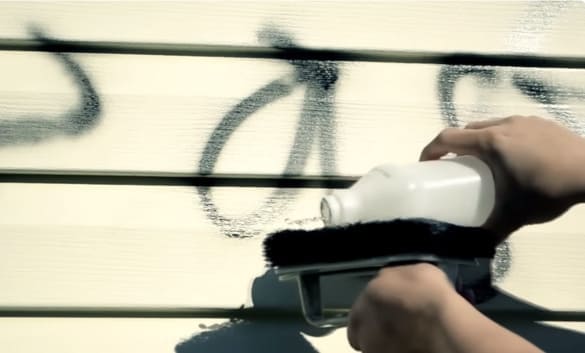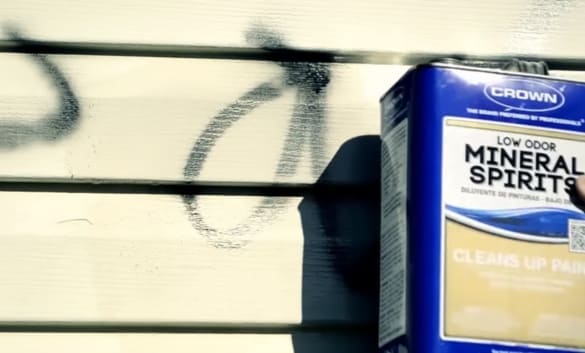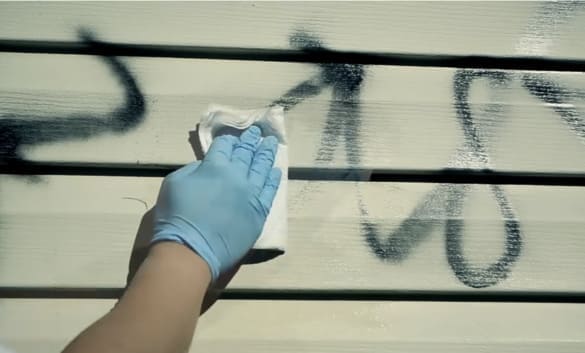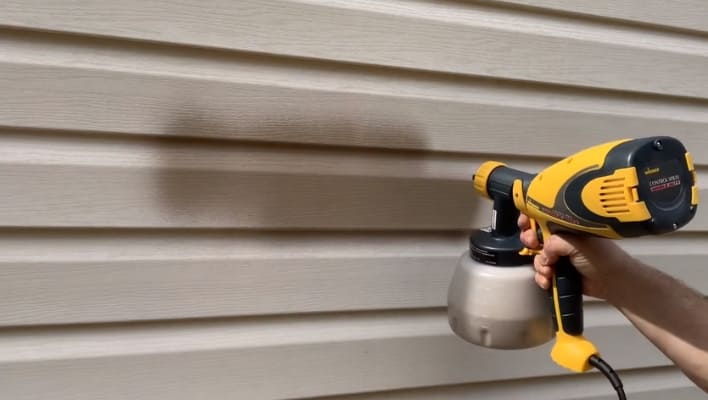If you’ve ever woken up to the sight of spray-painted graffiti on your precious vinyl siding, you’re not alone. It’s a common issue that can be quite a headache for homeowners, professionals, or anyone passionate about maintaining their property.
The good news is that spray paint on vinyl siding, while unsightly, doesn’t have to be a permanent blemish. In this guide, we’ll share a personal experience along with some valuable tips on how to effectively remove spray paint from vinyl siding, saving you the trouble and expense of replacing panels or dealing with insurance claims.

Table of Contents
- how To remove Spray paint from vinyl siding-Quick Summary-
- Can You Remove Paint From Vinyl Siding?
- how to remove spray paint from house siding? (Easy Method)
- Soap and Water Method:
- What removes wet spray paint From Vinyl Siding?
- Step 1: Prepare a Cleaning Solution
- Step 2: Apply the Cleaning Solution
- Step 3: Rinse the Area
- Step 4: Check for Remaining Paint
- Step 5: Use Isopropyl Alcohol (if necessary)
- Step 6: Rinse Once More
- Step 7: Final Inspection
- Removing Wet Oil-Based Paint
- How to remove dry spray paint from vinyl siding?
- Remove Dried Oil-Based Spray Paint:
- Remove Dried Water-Based Spray Paint:
- How to remove spray paint graffiti from vinyl siding?
- Personal Experience On How To Get Spray Paint Off Vinyl Siding
- Materials Needed:
- Can Spray Paint Damage Vinyl Siding?
- Why Should You Remove Spray Paint From Vinyl Siding?
- FAQS On how to remove spray paint from house siding
- What product removes paint from vinyl?
- Will acetone damage vinyl siding?
- What is the best solution for cleaning vinyl siding?
- Can paint thinner remove paint from vinyl siding?
- Can paint thinner damage vinyl siding?
- Is Goo Gone safe for vinyl siding?
- Conclusion On how to remove spray paint from vinyl siding
- Rosalie Sanchez
how To remove Spray paint from vinyl siding-Quick Summary-
To remove spray paint from vinyl siding, begin by testing a small area to ensure it won’t harm the siding. For water-based spray paint, mix one part laundry detergent with four parts warm water, apply, wait five minutes, and scrub.
Remove wet paint with warm water and a few drops of dish soap. If the paint is stubborn, consider a vinyl-safe graffiti remover. For dried paint, carefully use a paint scraper. Isopropyl alcohol can enhance the cleaning. Finally, gently rinsing the area with a pressure washer for a clean finish. Always use caution, especially with flammable products like mineral spirits. If it’s a complex job, professional help is a good option.
Can You Remove Paint From Vinyl Siding?
To remove paint from vinyl siding, follow these simple steps:
- Apply rubbing alcohol on a cloth and gently wipe off the paint.
- Scrub away the paint until it’s all gone.
- Use a mix of soap and warm water to clean the area and make your siding look like new.
Vinyl siding doesn’t form a strong bond with most paints, making it relatively easy to remove paint or stains. The specific paint type and how long it has been on the siding will influence your approach. If you’re planning to repaint your vinyl siding, proper preparation, including stripping off old paint and ensuring a clean surface, is essential.
Related Resource: Learn how to remove spray paint from plastic and wood.
how to remove spray paint from house siding? (Easy Method)
Quick action is important when dealing with spray paint on any surface. Fresher paint is easier to clean. This principle applies to removing spray paint from vinyl siding as well. Address the issue promptly for simpler removal. You need to act as soon as you see a problem; don’t wait. The following are some easy methods to remove graffiti from vinyl siding:
Soap and Water Method:
To remove paint from vinyl siding, you can easily create a cleaning solution by mixing half a bucket of lukewarm water with a few drops of dish soap. This will help gently clean the surface without causing damage.
What removes wet spray paint From Vinyl Siding?
Begin by determining whether the wet spray paint is oil-based or water-based, as the approach for removal varies depending on the type of paint.
Step 1: Prepare a Cleaning Solution
To deal with water-based paint, you should prepare a cleaning solution by mixing warm water with a small quantity of laundry detergent. Make sure that the detergent you choose doesn’t include bleach to avoid the risk of discoloration. Then, take a clean cloth or sponge, dip it into the cleaning solution, and you’re ready to go.
Step 2: Apply the Cleaning Solution
Take a clean cloth or a sponge and dip it into the cleaning solution.
Gently scrub the painted area on the vinyl siding in a circular motion to help lift the paint.
Step 3: Rinse the Area
After scrubbing, thoroughly rinse the treated area with clean, warm water. This will remove any remaining detergent and paint residue.
Step 4: Check for Remaining Paint
Inspect the surface for any traces or small paint specks that might still be present.
Step 5: Use Isopropyl Alcohol (if necessary)
If there are any persistent paint marks, you can employ isopropyl alcohol.
Moisten a clean rag with isopropyl alcohol and gently rub it over the remaining paint spots until they come off.
Step 6: Rinse Once More
After using isopropyl alcohol, give the area another thorough rinse with warm water to eliminate any traces of alcohol residue.
Step 7: Final Inspection
Finally, inspect the vinyl siding one last time to ensure that all the paint has been successfully removed.
Removing Wet Oil-Based Paint

Wet oil-based paint cannot be effectively removed with soapy water due to the incompatibility of oil and water. For this purpose, I usually use mineral spirits.
Before you begin, remember to follow safety precautions, as solvents like paint thinner are flammable, and dispose of used materials properly.
Wet oil-based paint cannot be effectively removed with soapy water due to the incompatibility of oil and water. To tackle this, you need a strong solvent like mineral spirits or paint thinner.
you can soak a clean cloth or rag in paint thinner or mineral spirits and then start applying paint thinner or mineral spirits to the stained area in a circular motion and let it sit for about 30 minutes, allowing it to soften and bubble.
Afterward, use isopropyl alcohol to clean off any remaining paint residue.
Wash the area with warm soapy water, using a scrubber if needed.
How to remove dry spray paint from vinyl siding?
Remove Dried Oil-Based Spray Paint:
When it comes to addressing dried oil-based spray paint on surfaces, acetone can be a valuable ally. Soak a clean cloth with acetone, then use it on the painted surface. As the acetone evaporates, keep rubbing the surface. You’ll observe the paint gradually lifting.
Ensure active involvement in the process and prevent acetone from seeping into the paint. With its effectiveness in handling various types of spray paint, acetone proves to be a useful household product for tackling resilient oil-based paint stains.
Related Resource: Read more about the differences between mineral spirit and acetone.
Remove Dried Water-Based Spray Paint:
If you’re contending with dried water-based spray paint, acetone may not be the ideal solution. In this case, consider alternative methods like using a plastic scraper and washing the area with soapy water. Acetone is primarily suited for oil-based paints.
Start by gently scraping off the paint with a plastic scraper, and then proceed to cleanse the area with warm, soapy water to eliminate any remaining residue. This approach is safer for water-based paints and minimizes the risk of surface damage.
How to remove spray paint graffiti from vinyl siding?
To effectively remove dried paint from vinyl siding, follow these steps:
- Choose a commercial graffiti remover that’s safe for use on vinyl siding. Look for the manufacturer’s recommendations on the product label.
- Various graffiti removers may come with specific guidelines for application, so it’s crucial to follow the instructions provided.
- Apply the graffiti remover to the painted area and let it sit for the specified duration, typically around 60 seconds.
- Following the recommended waiting time, take a clean cloth to wipe the treated area. In several instances, there could be residual paint left behind.
- If stubborn paint residue persists, you can opt to re apply the graffiti remover and repeat the wiping process.
- For more challenging graffiti removal tasks, it’s wise to consider hiring professionals who have access to specialized cleaning solutions and tools.
- Professionals possess the expertise to manage the entire process, from applying the cleaner to ensuring thorough rinsing.
Personal Experience On How To Get Spray Paint Off Vinyl Siding
Materials Needed:
Here are these materials which I have used to remove the process from your vinyl siding. Make sure you have them on hand before you start the cleanup.
- Motsenbocker’s Lift Off (spray paint remover)
- Safety Gear (Latex or nitrile gloves and safety goggles)
- Cleaning Supplies (Paper towels, Abrasion pad)
- Garden hose with a spray nozzle

This morning, like many others, I had the unfortunate surprise of discovering graffiti on the side of my house. As you can see in the picture above, the vandal seemed to be representing the “east side.” It wasn’t too extensive, but spray paint on vinyl siding can be a real challenge to remove without damaging the underlying paint. After scouring the internet for solutions, many suggested using “Goo- Off,” but it left a hazy blemish, as I had read online.

Then, I stumbled upon Motsenbocker Lift-Off, specifically designed for removing spray paint from various surfaces, including vinyl siding. It works on different types of spray paint, from enamel to acrylic, even stubborn brands like Rust-Oleum and permanent markers. The best part?
The product is reasonably priced at just eight dollars, available at stores like Lowe’s or Home Depot. However, a word of caution – always test a small area first, as it may cause damage to your siding. To ensure a safe and effective process, it’s important to thoroughly go through the product’s instructions and warnings.
Before using Motsenbocker’s Lift-Off, I tried several alternative methods. I tried rubbing alcohol, which yielded mixed results. While some paint came off, it wasn’t the most effective solution. I also attempted mineral spirits, which I had on hand from woodworking projects. Surprisingly, rubbing alcohol did a better job in this case, but the results were still subpar.
Now, coming to Motsenbocker Lift Off I followed the safety precautions and wore gloves. However, during the process, the latex gloves started thinning and tearing, so be cautious during prolonged exposure to the chemical.

As you can see in the picture, I began with a paper towel to ensure that no paint was coming off inadvertently, and it worked quite well. The paper towel alone managed to remove most of the spray paint.
For tougher spots, I turned to an abrasion pad, which I found to be a miracle worker. It’s essential to spray the product liberally and press firmly to get into the textured grooves of the vinyl. Otherwise, you risk smearing the spray paint to non-affected areas. In between scrubbing with the abrasion pad, I hosed down the excessive residue to reduce smearing. In some areas where the spray paint was deeply embedded, it took two or more applications to get everything removed.
Safety goggles are a must because the spray paint mist can get in the air and potentially reach eye level. One tip I’d offer is to have two abrasion pads handy since the first one can get gunked up and start smearing. They’re inexpensive, so it’s a worthwhile investment.
After the removal process, the siding looked great, almost as if nothing had happened. However, some minor residue was still visible in areas where the spray paint was deeply ingrained in the textured grooves. With a little elbow grease and patience, these spots were eventually removed, leaving the siding looking significantly better.
It’s worth mentioning that after the cleaning process, you may observe some spots or discoloration on the vinyl siding. In my situation, the sections I cleaned appeared marginally darker than the untouched areas. To mitigate this, I wiped down the entire siding with the spray to help blend everything together, and it did make a noticeable difference. You can check the final result after cleaning spray paint from vinyl siding in the picture below;

In the end, this method was a cost-effective alternative to replacing panels or dealing with insurance claims. Remember, always test your area first before attempting any cleaning method, and I hope these tips prove helpful in tackling unwanted graffiti on your vinyl siding.
Can Spray Paint Damage Vinyl Siding?
Spray painting vinyl siding can potentially lead to damage if not done correctly. Using dark colors can absorb heat, causing the siding to expand dramatically. This may result in the vinyl not returning to its original dimensions.
To prevent potential damage, it’s advisable to utilize specialized spray paint specifically formulated for vinyl siding. This paint is typically composed of 100 percent acrylic resins or a combination of acrylic and urethane resins. Choosing the right color is crucial, as darker shades can cause warping due to heat absorption from the sun.
Why Should You Remove Spray Paint From Vinyl Siding?
Taking off spray paint from vinyl siding is really important for a few reasons. Firstly, it ensures that new paint adheres properly, creating a durable finish. Secondly, if the new paint is darker than the existing siding color, removing the old layer is necessary to maintain color consistency. Accidental paint splatters can also be corrected without causing damage to the siding.
Additionally, using the right type of paint is vital, as not all paints are suitable for vinyl siding. Lastly, some homeowners prefer a low-maintenance approach, opting to strip off paint entirely to enjoy virtually maintenance-free vinyl siding. It’s a versatile solution that caters to the needs of professionals and DIY enthusiasts, enhancing the longevity and aesthetics of your home’s exterior.
FAQS On how to remove spray paint from house siding
What product removes paint from vinyl?
Wondering what works to get paint off vinyl? Check out these options:
- Goof Off
- Klean-Strip
- Motsenbocker’s Lift Off (My favourite option for cleaning vinyl siding)
- Citristrip
Will acetone damage vinyl siding?
Using acetone on vinyl siding is okay as long as you dilute it and work quickly. But if it’s too strong, it could harm the vinyl by changing its shape or color. Paint thinners, which are also solvents, can cause damage and discoloration too. Just be careful with concentration and work fast.
What is the best solution for cleaning vinyl siding?
You can make a solution with 30% vinegar and 70% water to clean vinyl siding effectively. This mix helps get rid of mold without using harsh bleach. Another good homemade cleaner is dish soap and water. You can also use rubbing alcohol and a vinegar solution which work well without harming the vinyl.
Can paint thinner remove paint from vinyl siding?
Yes, paint thinner can remove paint from vinyl siding, and it may make the siding appear dull. To prevent this, dilute the thinner with 10 parts water to 1 part thinner and test it on a small hidden spot before applying it to the paint.
Can paint thinner damage vinyl siding?
Yes, it can. Paint thinners, like acetone, are solvents and can harm the siding by causing layer damage and discoloration.
Is Goo Gone safe for vinyl siding?
Yes, Goo Gone is safe for vinyl siding and can get rid of graffiti without causing harm. Just test it in a hidden spot first to be sure.
Conclusion On how to remove spray paint from vinyl siding
In conclusion, removing spray paint from vinyl siding can be tackled with various methods, from DIY approaches like water and soap to professional services. Test methods in a small area, prioritize safety, and find the solution that fits your needs and budget.

Rosalie Sanchez
DIY enthusiast with years of experience in home decor and home improvement. With a passion for educating consumers about DIY projects. Every time, I work with our painting professionals to provide you with the best painting product reviews and how-to advice. You can follow me on Facebook.


